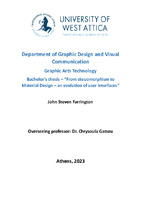| dc.contributor.advisor | GATSOU, CHRYSOULA | |
| dc.contributor.author | Φάρρινγκτον, Ιωάννης - Στέφανος | |
| dc.date.accessioned | 2024-10-09T07:32:57Z | |
| dc.date.available | 2024-10-09T07:32:57Z | |
| dc.date.issued | 2023-08-10 | |
| dc.identifier.uri | https://polynoe.lib.uniwa.gr/xmlui/handle/11400/7635 | |
| dc.identifier.uri | http://dx.doi.org/10.26265/polynoe-7467 | |
| dc.description.abstract | Οι διεπιφάνειες εργασίας είναι μια ιδέα με τις ρίζες της στα τέλη του 19ου και τις αρχές
του 20ου αιώνα. Στις απαρχές των ηλεκτρονικών υπολογιστών, οι διεπιφάνειες
εστίαζαν στην ικανότητα του χρήστη να μπορεί να ελέγχει τα μέλη των μεγάλων και
σύνθετων υπολογιστών της τότε εποχής. Με την πάροδο του χρόνου, οι διεπιφάνειες
εργασίας έπρεπε να γίνουν απλούστερες και χρηστικότερες, αντανακλώντας την
μετάβαση από ηλεκτρικούς και μηχανικούς σε ηλεκτρονικούς υπολογιστές. Η
τεχνολογία εξελίχθηκε στο σημείο οπού μπορούσαν να χρησιμοποιηθούν γραμμές
εντολών. Στην συνέχεια, χρησιμοποιήθηκαν εικονίδια και σύμβολα ως μεταφορές για
να μπορούν όλο και περισσότεροι χρήστες να χρησιμοποιήσουν εύκολα ηλεκτρονικούς
υπολογιστές, προσιτοί πλέον λόγω τεχνολογίας και χαμηλών τιμών. Οι περισσότεροι
πλέον χρήστες θα έφτιαχναν τις δικές τους εφαρμογές και ιστοσελίδες στο διαδίκτυο,
με άτακτες και ιδιόρρυθμες συνθέσεις, για να τραβήξουν την προσοχή του χρήστη. Οι
αλλαγές αυτές έλαβαν το όνομα “web 2.0”. Μια ωρίμανση κατά την διάρκεια της
επόμενης χιλιετίας έδωσε στις επιφάνειες εργασίας τις χαρακτηριστικές τους καθαρές
λευκές επιφάνειες και καμπύλες. Η απαίτηση πολλών χρηστών να έχουν πρόσβαση σε
περισσότερες λειτουργείες και η επιθυμία τους οι επιφάνειες να αντανακλούν
αντικείμενα της καθημερινότητας έδωσε προβάδισμα στον «σκευομορφισμό». Η πυκνή
παρουσίαση του σε συνδυασμό με την τεχνολογική εξέλιξη, σήμαινε πως οι σύγχρονες,
«επίπεδες» επιφάνειες εργασίας θα κυριαρχούσαν, με την ικανότητα τους να
ανακατατάσσονται χωρίς πρόβλημα από συσκευή σε συσκευή. Η έλλειψη πληροφορίας
σε συνδυασμό με απούσα πολλές φορές ανατροφοδότηση για τον χρήστη, οδήγησε
στην δημιουργία του “Material Design”, ένα νέο είδος διεπιφάνειας εργασίας, που
χρησιμοποιούσε ήχο, εικόνα και κίνηση για να δώσει στοιχεία στον χρήστη, ενώ
παράλληλα διαχειρίζονταν την επιφάνεια της ως ένα τρισδιάστατο φύλλο χαρτιού.
Μέσω αυτών των ιδιοτήτων ο χρήστης καθοδηγείται οργανικά στον στόχο του. | el |
| dc.format.extent | 79 | el |
| dc.language.iso | en | el |
| dc.publisher | Πανεπιστήμιο Δυτικής Αττικής | el |
| dc.rights | Αναφορά Δημιουργού - Μη Εμπορική Χρήση - Παρόμοια Διανομή 4.0 Διεθνές | * |
| dc.rights.uri | https://creativecommons.org/licenses/by-nc-sa/4.0/deed.el | * |
| dc.subject | Interface | el |
| dc.subject | Command line | el |
| dc.subject | Web 2.0 | el |
| dc.subject | Y2K | el |
| dc.subject | Skeuomorphism | el |
| dc.subject | Material design | el |
| dc.subject | Flat design | el |
| dc.title | "From Skeuomorphism to Material Design - an evolution of user interfaces" | el |
| dc.title.alternative | "Απο τον Σκευομορφισμό στο Material Design - μια εξέλιξη των διεπιφανειών εργασίας" | el |
| dc.type | Πτυχιακή εργασία | el |
| dc.contributor.committee | Καραμάνη, Αντιγόνη | |
| dc.contributor.faculty | Σχολή Εφαρμοσμένων Τεχνών & Πολιτισμού | el |
| dc.contributor.department | Τμήμα Γραφιστικής και Οπτικής Επικοινωνίας | el |
| dc.description.abstracttranslated | User interfaces have been an ever evolving concept, with their roots going all the way
back to the early 20th and late 19th century. In their earliest stages, user interfaces were
much more about being able to control the mechanical parts of the then large and
complicated computers of the time. As time went on, computers would change from
mechanical to electronic, and a simpler and more intuitive user interface would be
needed. Advancements in science and technology would give us the first examples of a
command line interface. In order to make computers more approachable and usable for
more people, the idea of abstracting applications and commands through the use of
icons would take place in the 80s. This, along with the falling prices of computers, meant
that the barrier to entry would come down for users. The increase in computer usage
and the rise of internet websites, would cause the World Wide Web to evolve into what
is known today as “web 2.0”. Design would become unruly and eye-catching in order to
attract a user’s attention as much as possible. As technology matured, aesthetics would
come to play a larger role in design. The new millennium would bring with it a refined
and futuristic style, full of curves and clean surfaces. This clean style would then evolve
into “skeuomorphism”, mainly due to the rising complexity and power of computers.
Users wanted an interface that would mimic real-world items as much as possible while
also offering a plethora of functions and selections constantly on the application’s
desktop. This would prove tiring and taxing however, and simpler, “flatter” interfaces
would start to dominate modern technology, with their look and feel being able to easily
adapt from one form factor to another. The chief complaint of flatter interfaces, of
course was the lack of information and feedback toward the user. This would eventually
be addressed through the new style of interface known as “Material Design”, which
would treat interfaces like a more three-dimensional piece of paper instead of a flat
plane, while also using sound and animation to guide the user organically | el |


